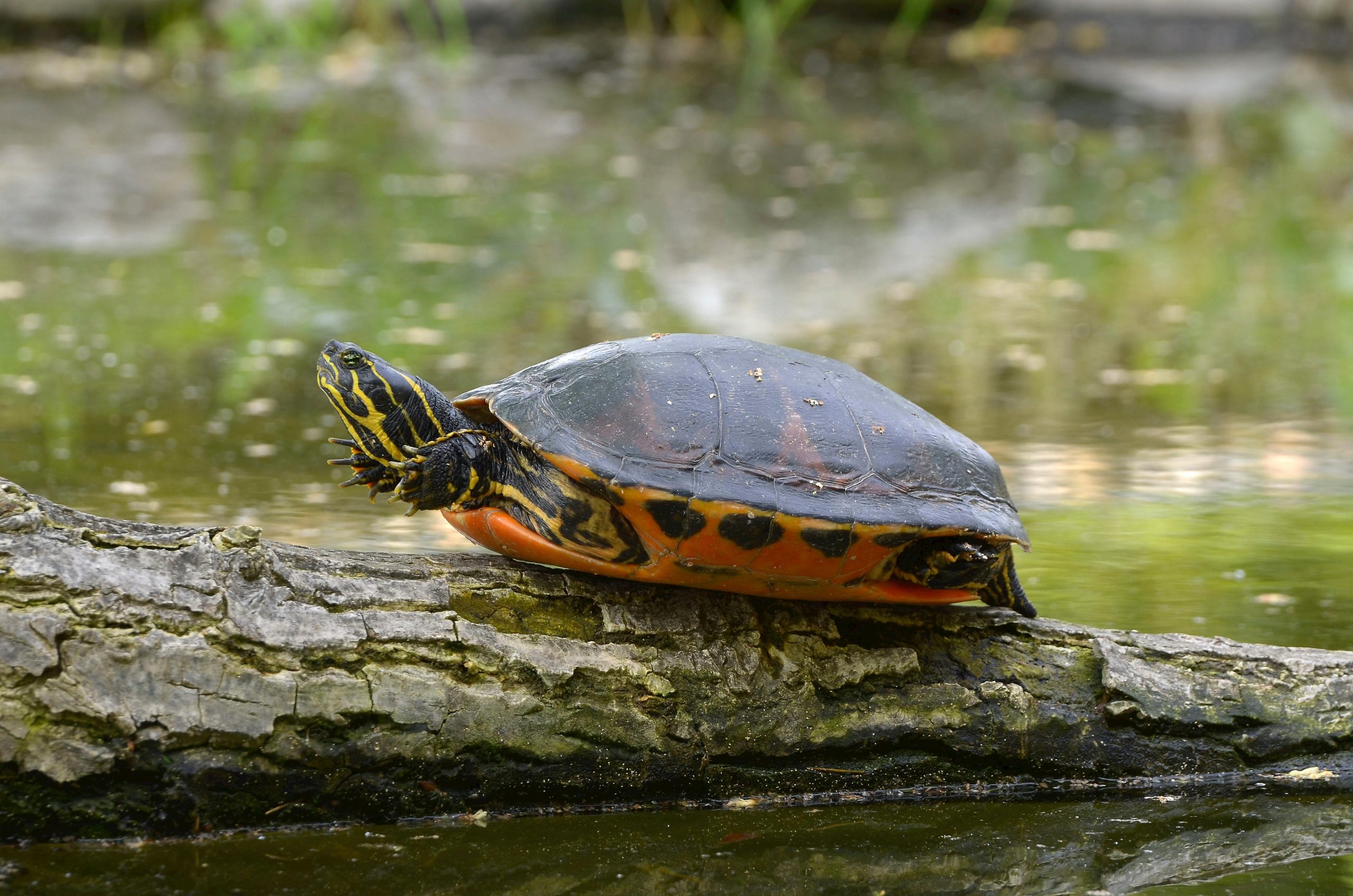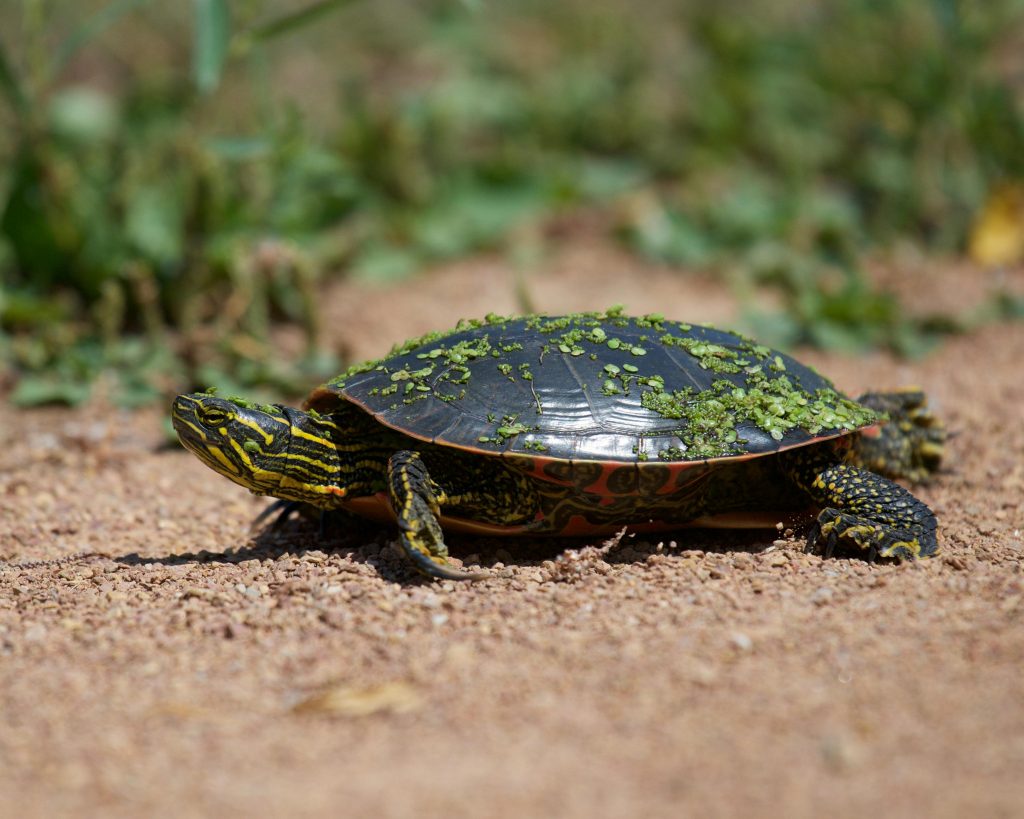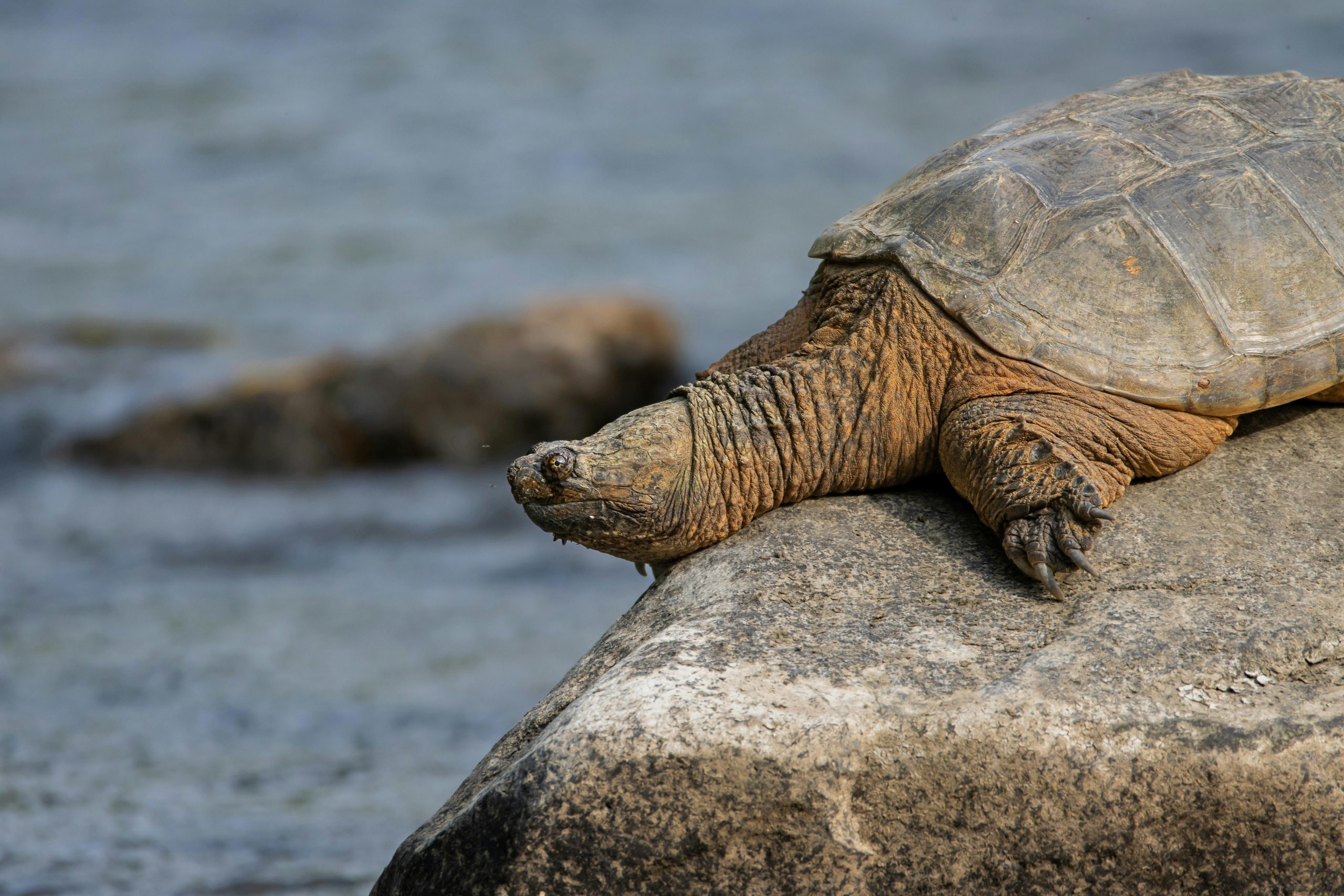How To Take Care Of A Painted Turtle?

Do you have a painted turtle? Or are you planning to make one as pet? Does taking care of a painted turtle seem too confusing for you? I totally agree! Though painted turtles are gorgeous pets, taking care of them is not easy. They require specific things, temperature, and certain items in their habitat to stay happy and healthy.
Though, if you have a step by step guideline on what to do and what to avoid, you can easily take care of your painted turtles. All you need is just a in-depth guideline.
And this is what I am giving you in this article. Here, I’ll explain in detail how to take care of a painted turtle.
Installing A Turtle Tank
This is the first thing to consider for the captive turtle. The tank you will provide will be their home, think about it! You cannot imitate all the things they enjoy in the wild, sadly this is the truth.
The good news is you can make their home super comfy and cozy! A tank, Water, water heater, filter, UV lights, and basking place are the basic things to set up a perfect turtle home.
Water
You will need at least 20 gallons of water for one adult painted turtle. If you got more than one painted turtle you need to add 10 gallons of extra water for each additional painted turtle.
For one baby turtles, you will need 10 gallons of water and each additional turtle in the same tank will need an additional 5 gallons of water.
Try to change the water of the tank in between 1 to 3 weeks. In the meantime, you can siphon water regularly to keep the tank clean.
The recommended pH level for water is from 5.5 to 7. You need to monitor the pH level every four days for the first month so that you can maintain the proper pH level.
I use this aquarium test kit to check various parameters of the aquarium water.
Disinfect The Tank
Disinfecting the tank is highly recommended to keep your painted turtle healthy. If you use a solution to disinfect water regularly, you don’t need to disinfect the tank regularly. You can disinfect the tank in every 45 to 50 days.
If you don’t use a solution for disinfecting the water you need to disinfect your tank more regularly. Have a close eye on water quality and your turtle’s behavior.
Remember the measurement of water is given here is minimum, adding more water is always better.
Turtle needs deep water, they enjoy swimming underwater, and a deeper tank is a great option. Turtle needs to flip back if it does turn upside down.
Thermometer And Water Heater
Keeping a thermometer and water heater for your turtle’s tank is a must, although many people think it is not necessary.
The sudden fluctuation of temperature can lead your turtle to fall ill. The clever idea is to install a thermometer to keep an eye on the temperature. The temperature of the water for captive turtle should be between 75-78 degrees Fahrenheit.
If you notice the temperature going down from the recommended value, turn on the water heater to keep the temperature stable.
Remember respiratory trouble is common in turtles around the winter season. It’s better to use a submersible water heater for a constant temperature in your turtle tank. Remember to hide the thermometer behind any nontoxic object in the tank otherwise curious turtle can break the thermometer anyhow.
I really love this digital thermometer for my turtle tank. It shows digital result which is pretty accurate! For the water heater, nothing can beat this one. it is the most reliable one I found till now.
Filter
Turtle produces a huge amount of waste so you need to set up a strong water filter. The best-recommended filter is canister filters. However, if you can’t afford the canister filter initially you can use an internal filter. Try to use two of them.
Remember the huge amount of waste will clog your filter often. So apparently it may seem that canister filter is expensive but really it is not.
I have been using this conister filter from the very beginning and till now I am completely satisfied with its performance.
UV- Light
Turtles need abandon of sunlight. In the wild, they spend most of the time they spend by basking in the sun. As you keep your turtle indoors you need to install UV lights to substitute the sunlight. Install a UV light that has got both UV-A and UV-B.
The UVA light keeps the painted turtle busy and helps to maintain appetite. The UVB light helps them to produce vitamin D3. Without vitamin D calcium absorption is impossible and to maintain a healthy shell painted turtle needs vitamin D.
Just get this lighting kit and you’ll be good to go!
Basking Spot And Hiding Spot
Basking is painted turtles’ favorite pastime as it allows them to dry up completely. Drying up completely is very much necessary for turtles. Without drying up they may get caught by the parasite as well as fungus infection.
However by driftwood, you can make a basking spot for your turtles, or you can buy a premade basking spot for your turtles. You can even choose above the tank basking spot, they are great and I recommend. Basking place is for drying up completely, there should no drops of water exist.
Never forget to place UV spotlights over the basking area.
If you are planning to make their habitat outdoors, that is great! Please make sure that at least one area is open to the sun. Painted turtles need to get out of the water completely while basking and they love getting warm in the sun.
Smooth rocks, driftwood or corkboard can make excellent basking place in the outdoor habitat. Just make sure there is no sharp object. A sharp object can make scratch oh their shell.
In the tank, there should be a hiding spot for your painted turtle. Painted turtle go and takes a hide if they feel insecure. It’s their instinct. You can easily make a hiding spot at the bottom of their tank by using real or fake plants.
Just make sure there should not be any chance to get trapped. Turtle may end up dying if they get trapped in their hiding spot. Try to make that simple. Fake or real plants use whichever is not toxic for turtles.

This is my all time favorite basking place for for painted turtles. This is a tank topper type basking platform which suits well in any type of turtle tank!
Feeding Your Painted Turtle
Painted turtles can eat a variety of food like chicken, insects or different fish and worms. They also enjoy fruits and vegetables.
Adults turtles should not be fed daily. Daily feeding can make them overweight. You should feed your adult painted turtle in every alternate day or every two days according to their weight and age.
Like human every painted turtle is different. One may like to eat a veggie or another may like to eat insects. You need to take care of this. To ensure that they should live a healthy life you should make sure that they are having all types of vitamins and minerals.
Try to offer a variety of veggies. Chopped mixed veggies are a great option. You can occasionally offer fruit as a treat.
Don’t offer them any citrus fruit or avocado. Dairy food or raw meat is not recommended for the painted turtle.
Try not to give food that is not recommended for turtle, for example, bread or other cooked food made for humans.
Offer them pellets too, but be careful only pellets diet is not recommended. In an emergency sometimes you can offer low-fat dog pellets to your turtle too.
Supplements
Supplements are necessary for painted turtle along with the regular food. Provide A calcium block or cuttlefish bone in their tank. Or you can sprinkle some calcium supplements on their regular food. The multivitamin supplement should be offered twice a week.
This suppliment will be sufficient for any painted turtle!
Taking Care Of Juvenile Painted Turtle
Many of us like to adopt baby painted, this is great. Growing old with our companion animals is very rewarding. One thing to consider before adopting a baby turtle, you should not bring a baby turtle less than 4”. Buying and selling a painted turtle less than 4” is not legal in the USA (Title 21 CFR 1240.62).
A baby turtle is like a toddler, they are very active and playful. While housing your baby painted turtle remember she can grow up to 10”. So try to arrange a bigger home so that you don’t need to invest twice as well as the baby got a bigger playground.
Remember it is wise to get them from the pet store, catching them from the wild is not recommended.
Commercial turtle food is an easy option but remembers baby turtles grow up real fast. Their growing body needs protein along with different vitamins and minerals. Don’t give pellets more than 25% of their total food.
Baby turtles need to be fed every day. They enjoy eating living foods, it’s better to offer them live foods. Brine shrimps, brown or black worms, and guppies can be great living food to offer your baby painted turtle.
Try to offer small pieces of cooked beef or chicken, some other fish like small pieces of salmon as they grow up. Also, offer fruits and veggies, they might not eat them initially but you should keep on adding a variety of foods as they grow up.
Do not forget to use calcium and vitamin supplements in their food. Remove any excess food after feeding them to avoid building up harmful bacteria.
We use plants in aquarium mostly to decorate the tank, and this is optional. Adding natural plants in the baby painted turtle’s tank can add some real value.
Real plants in the tank can help you to keep the tank clean and increase the oxygen level in the water. By adding aquatic plant you can boost the mood of your baby turtle if they are stressed.
Just make sure you are picking the right plant for your painted turtle’s tank. Java Fern, waterweed or any Anubias Species are some well-recommended plants for your baby turtle’s tank.
Just make sure you are picking the right plant for your painted turtle’s tank. Java Fern, waterweed or any Anubias Species are some well-recommended plants for your baby turtle’s tank.
Never use under gravel filter, it will pull all the waste down to the gravel, many harmful ammonia and bacteria will build up and that is a straight threat for the health of your baby turtle.
Never ignore any sign of illness, or any uncommon behavior of your baby painted turtle. Never delay visiting the animal doctor whenever it is necessary.
Things To Avoid
Avoid feeding your turtle dairy products, not even a small treat is not recommended. Their anatomy does not allow them to digest lactose. Try to avoid giving them processed food, foods with a chemical preservative, canned food. Don’t cook their meat in a nonstick pan.
Turtles don’t like to be watched while eating. If you think that your turtle is not eating around people, leave her alone after serving food.
Remember turtles are not cat or dog, they don’t like to be handled. The less you handle them the more they will feel secure, try to avoid handling as much as you can. Don’t forget to wash your hand with soapy water after handling painted turtle, they carry salmonella.
Turtles hate to put on their back, don’t do that with your pet turtle. Don’t grab their tail. Too much handling makes them stressed out.
Never purchase wild-caught turtle. As a pet lover, this is your responsibility to support safe pet trade. Captive-bred turtles are healthy and easily cope with a human.
Never leave your dog and painted turtle without supervision. Your dog can anytime tear open your beautiful painted turtle.
Leaving your baby and turtle is alone is not a good idea either.
Common Health Issues
Falling ill is a natural phenomenon for every living being, there is no room for thinking that I did everything perfect for my painted turtle. They can catch illness anytime, you should know the warning signs to get to know that something might be wrong.
Here I am giving you some warning symptoms of the painted turtle if you find any of the signs in your companion painted turtle you should consider going to a vet.
- Swelling or sunken eyes
- Decreased Appetite
- Watery discharge from eyes
- Mouth breathing
- Runny nose
- Inability to submerge
- A wound on the skin
- Wound on the shell
- Discolored shell
You know what, turtles have a tendency to hide their illness, this is a common wild instinct. Many animals do not show their illness, it is a survival trick. However, they can misguide their predators by hiding illness in the wild but they can’t do that with the vet.
So yearly visit to the vet is highly recommended. Any unexplained abnormal behavior of your companion painted turtle should be checked by a vet also. Remember, it’s you who can help them in times of trouble.
Your pet, Your responsibility.
Making Your Turtle Super Happy
A happy turtle will have a longer healthy life. Let’s learn tricks and tips for making your turtle happy-
Think out of the box, you can provide them a bigger tank than the recommended. Remember the recommended size is the minimum requirement. In the wild they roam around in the big area, try to provide them with a big tank as a minimum imitation of their wild home.
Turtles are messy eaters, so try to provide them with a separate tank for eating. That will make less scrap in their tank. Less scrap means less ammonia and nitrate level, which is good for them.
Use a soft toothbrush to clean the algae on turtle’s shell. Turtles shed, and the process of shedding the scutes of turtle become itchy, cleaning the shell will soothe them.
Handle your turtle with love, they may not understand your language but affection has got its language and your turtle knows it.
There is no harm in giving them a small snack time some time. In the wild turtle often chase their food and they love it. You can provide living food for your turtles like wax worms or live crickets. They will love to chase them to eat.
They will enjoy the time if you let them play outside of their tank. Try to give them some out of tank time to exercise. Keep an eye while they roam around out of their tank, to avoid any fatal accident.
Conclusion
Wow! You are still with me. Hope that you have a clear understanding of keeping a painted turtle healthy and happy. If you are still wondering for some additional information on how to take care of a painted turtle, you can simply browse on this site more.
Some FAQs And Answers:
Q. Is there any other animal that turtles get easily along with?
Guppies, minnows or goldfish are some types of fish that you can keep in the same tank with your turtle. There is a chance that your turtle can eat them but as they are not expensive you can restock them.
Q. Is it safe to give toys like a small ball to my turtle?
Your turtle will love to push around the ball. Make sure the ball is bigger to avoid choking hazards.
Q. Why my turtle is not eating, should I go to the vet?
First, try to check the temperature of the water. Turtle stops eating in a cooler environment. If the temperature of the water is lower than the recommended value run the water heater. Your turtle will start to eat.
Even after fixing the temperature if your turtle refuses to eat, it is time to go to the vet.
Q. Why does my turtle start hissing if I catch her?
Turtles make the hissing sound when something is not right. The turtle doesn’t want to be handled if it is making the sound while being held.
Q. Can I keep more than one painted turtle together?
Young ones easily get along with other young turtles. Once they get mature they start getting a hormonal rush that can make some of them aggressive. So if you are planning to put more than one turtle in the same tank, make hiding places for each of them.
Q. When my turtles will start to recognize me?
They will not start to recognize right after you bring them to your home. Gradually they will start to recognize you. Soon you will find that they will swim up after seeing you around.
Q. Is it possible for a turtle to come out of its shell?
In cartoons it is possible, but in real life, it is never possible. Never try to make a turtle come out of its shell.
Q. Do turtles have sensitivity on their shells?
One hundred percent! They have feelings in their shells. The painted turtle can feel pain on its shell. Some people drill a hole in their shell to carry them easily, this is extremely painful for turtles.


![Bog Turtle Care Manual [Step By Step Guide] Bog Turtle Care Manual [Step By Step Guide]](https://spreadhapiness.b-cdn.net/wp-content/uploads/2024/03/bog-1.jpg)








![Turtle Vs. Tortoise Vs. Terrapin [Difference Chart] Turtle Vs. Tortoise Vs. Terrapin [Difference Chart]](https://spreadhapiness.b-cdn.net/wp-content/uploads/2024/04/terrapin-1-120x120.jpg)




![How Can I Ship My Turtle? [Foolproof Guide] How Can I Ship My Turtle? [Foolproof Guide]](https://spreadhapiness.b-cdn.net/wp-content/uploads/2024/04/4.-1-120x120.jpg)